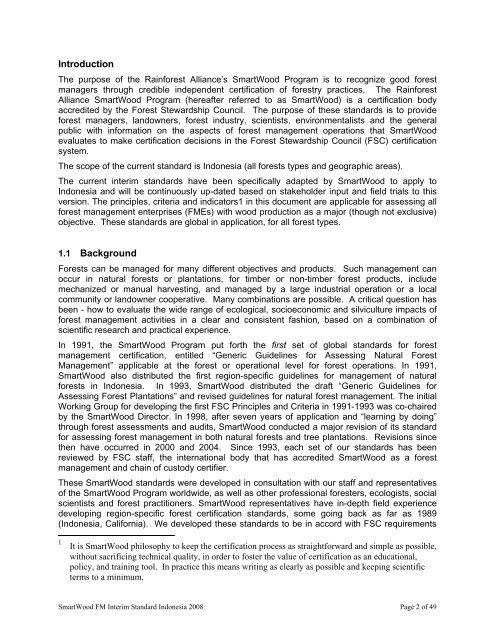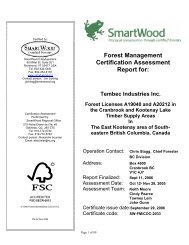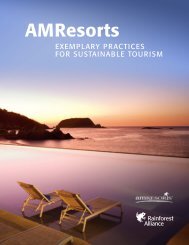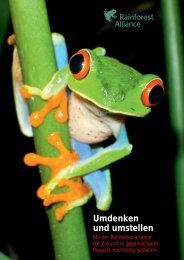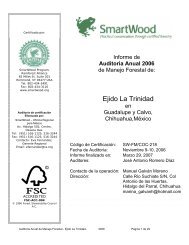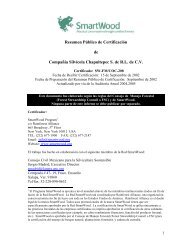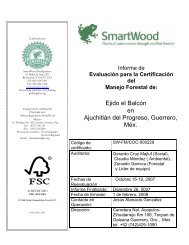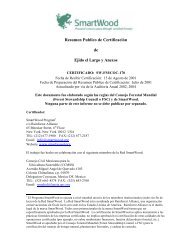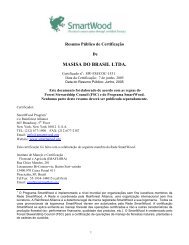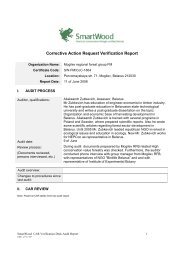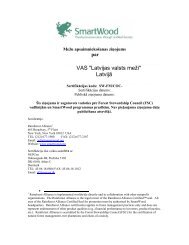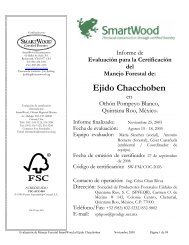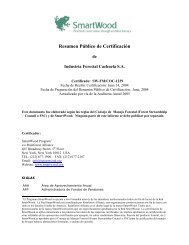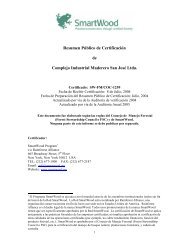Title: Rainforest Alliance/SmartWood Interim Standard for Assessing ...
Title: Rainforest Alliance/SmartWood Interim Standard for Assessing ...
Title: Rainforest Alliance/SmartWood Interim Standard for Assessing ...
Create successful ePaper yourself
Turn your PDF publications into a flip-book with our unique Google optimized e-Paper software.
Introduction<br />
The purpose of the <strong>Rain<strong>for</strong>est</strong> <strong>Alliance</strong>’s <strong>SmartWood</strong> Program is to recognize good <strong>for</strong>est<br />
managers through credible independent certification of <strong>for</strong>estry practices. The <strong>Rain<strong>for</strong>est</strong><br />
<strong>Alliance</strong> <strong>SmartWood</strong> Program (hereafter referred to as <strong>SmartWood</strong>) is a certification body<br />
accredited by the Forest Stewardship Council. The purpose of these standards is to provide<br />
<strong>for</strong>est managers, landowners, <strong>for</strong>est industry, scientists, environmentalists and the general<br />
public with in<strong>for</strong>mation on the aspects of <strong>for</strong>est management operations that <strong>SmartWood</strong><br />
evaluates to make certification decisions in the Forest Stewardship Council (FSC) certification<br />
system.<br />
The scope of the current standard is Indonesia (all <strong>for</strong>ests types and geographic areas).<br />
The current interim standards have been specifically adapted by <strong>SmartWood</strong> to apply to<br />
Indonesia and will be continuously up-dated based on stakeholder input and field trials to this<br />
version. The principles, criteria and indicators1 in this document are applicable <strong>for</strong> assessing all<br />
<strong>for</strong>est management enterprises (FMEs) with wood production as a major (though not exclusive)<br />
objective. These standards are global in application, <strong>for</strong> all <strong>for</strong>est types.<br />
1.1 Background<br />
Forests can be managed <strong>for</strong> many different objectives and products. Such management can<br />
occur in natural <strong>for</strong>ests or plantations, <strong>for</strong> timber or non-timber <strong>for</strong>est products, include<br />
mechanized or manual harvesting, and managed by a large industrial operation or a local<br />
community or landowner cooperative. Many combinations are possible. A critical question has<br />
been - how to evaluate the wide range of ecological, socioeconomic and silviculture impacts of<br />
<strong>for</strong>est management activities in a clear and consistent fashion, based on a combination of<br />
scientific research and practical experience.<br />
In 1991, the <strong>SmartWood</strong> Program put <strong>for</strong>th the first set of global standards <strong>for</strong> <strong>for</strong>est<br />
management certification, entitled “Generic Guidelines <strong>for</strong> <strong>Assessing</strong> Natural Forest<br />
Management” applicable at the <strong>for</strong>est or operational level <strong>for</strong> <strong>for</strong>est operations. In 1991,<br />
<strong>SmartWood</strong> also distributed the first region-specific guidelines <strong>for</strong> management of natural<br />
<strong>for</strong>ests in Indonesia. In 1993, <strong>SmartWood</strong> distributed the draft “Generic Guidelines <strong>for</strong><br />
<strong>Assessing</strong> Forest Plantations” and revised guidelines <strong>for</strong> natural <strong>for</strong>est management. The initial<br />
Working Group <strong>for</strong> developing the first FSC Principles and Criteria in 1991-1993 was co-chaired<br />
by the <strong>SmartWood</strong> Director. In 1998, after seven years of application and “learning by doing”<br />
through <strong>for</strong>est assessments and audits, <strong>SmartWood</strong> conducted a major revision of its standard<br />
<strong>for</strong> assessing <strong>for</strong>est management in both natural <strong>for</strong>ests and tree plantations. Revisions since<br />
then have occurred in 2000 and 2004. Since 1993, each set of our standards has been<br />
reviewed by FSC staff, the international body that has accredited <strong>SmartWood</strong> as a <strong>for</strong>est<br />
management and chain of custody certifier.<br />
These <strong>SmartWood</strong> standards were developed in consultation with our staff and representatives<br />
of the <strong>SmartWood</strong> Program worldwide, as well as other professional <strong>for</strong>esters, ecologists, social<br />
scientists and <strong>for</strong>est practitioners. <strong>SmartWood</strong> representatives have in-depth field experience<br />
developing region-specific <strong>for</strong>est certification standards, some going back as far as 1989<br />
(Indonesia, Cali<strong>for</strong>nia). We developed these standards to be in accord with FSC requirements<br />
1<br />
It is <strong>SmartWood</strong> philosophy to keep the certification process as straight<strong>for</strong>ward and simple as possible,<br />
without sacrificing technical quality, in order to foster the value of certification as an educational,<br />
policy, and training tool. In practice this means writing as clearly as possible and keeping scientific<br />
terms to a minimum.<br />
<strong>SmartWood</strong> FM <strong>Interim</strong> <strong>Standard</strong> Indonesia 2008 Page 2 of 49


